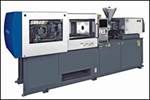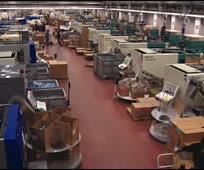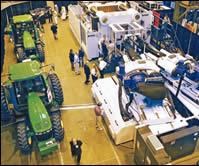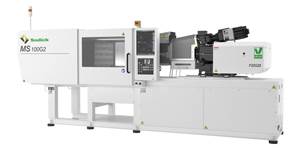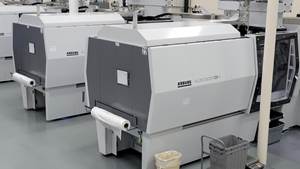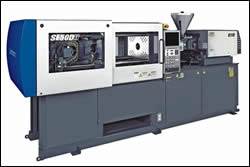Electric, Hydraulic, or Hybrid? What's the Right Injection Press for You?
If you were buying an injection molding machine 20 years ago, you had to decide between a toggle or fully hydraulic clamp and that was pretty much it.
If you were buying an injection molding machine 20 years ago, you had to decide between a toggle or fully hydraulic clamp and that was pretty much it. Today, your choices are a lot more complicated. Nearly every major injection machinery OEM offers one or more alternatives to “traditional” presses powered entirely by hydraulics.Starting in 1984, all-electric machines began trickling into the market from Japan. Initially, they looked like an expensive specialty that would occupy a niche market for high-precision, medical, or electronics molding on smaller presses. Then the trickle became a flood. Electric machines now span the full size range from micro to mega and are available for everything from general-purpose to multi-component and vertical insert molding.
Not only are there a wide variety of all-electric designs, but also electric-hydraulic hybrids of various types that seek an intermediate balance of cost and performance. These range from essentially hydraulic machines with only an electric screw drive to mostly electric machines that retain hydraulics for high-pressure clamping or high injection rates.
Now that hydraulic machines have ceded a significant portion of the market to electrics and hybrids, is it possible to define where each type fits in? The answer provided by numerous interviews with machine builders and molders is: It depends. It may depend on the type of molding you do, on the size of machine, on what you pay for electricity, and on personal preferences in matters such as “direct-pressure” clamping versus a toggle. In short, there appear to be no easy answers.
Inroads for electrics
In the U.S., all-electric injection machines comprised around 47% of sales last year, according to figures from the Society of the Plastics Industry (though it’s not clear whether some hybrids are included in that number). That huge penetration occurred despite prices that started out about 40% greater than hydraulic machines and are now more like 10% to 20% higher, according to most sources.
What fueled the electric invasion was a long list of advertised advantages:
- Energy savings from 30% to 70%.
- Increased precision and repeatability—e.g., positioning accuracy of ±0.0001 in., which can reduce scrap rates.
- Injection speeds up to 800 mm/sec or more and faster clamp motion too.
- Faster response, such as acceleration/deceleration times as little as 0.2 millisec.
- Ability to overlap screw recovery and clamp movements for up to 20% faster cycles.
- Faster start-ups and shorter times to achieve a stable process, without waiting for oil to warm up.
- Lower maintenance with no oil to clean and maintain.
- Quieter operation (<65 dbA).
- Cleaner operation (no oil) for clean-room medical and electronics molding.
According to sources at Milacron, which collaborated with Fanuc of Japan to pioneer the introduction of electric machines to the U.S., energy savings are the number-one justification for their purchase, followed by increased precision and repeatability. (Table 1 presents some comparisons of electric vs. hydraulic and hybrid performance.)
In Japan, where electric machines reportedly occupy at least 80% of the market, machine builders say high electricity costs are a prime reason, followed by the desire for greater molding precision and lower maintenance. In Western Europe, however, molders have been more resistant to higher prices for electric machines, which are said to have no more than about 8% of the market. Apparently, more molders there feel they can achieve adequately tight tolerances with hydraulic presses.
Although hydraulic machines still dominate most press makers’ product lines, some OEMs have abandoned hydraulics altogether. Niigata discontinued making hydraulic presses in 2005 and sells only all-electrics today. Toshiba also discontinued hydraulic machines under 200 tons in 2005, and Sumitomo stopped building any hydraulic presses this past January. “Ninety-nine percent of our business is all-electric, and 1% is hybrid,” says Jeff Hicks, v.p. of technical sales at Sumitomo. “It did not make sense to carry the hydraulic line,” he said.
JSW now markets only electric presses in North America. “Sales of all-electric machines made up 95% of our sales here last year,” says Robert Columbus, general sales manager.
The vast majority of machine builders today offer a choice of hydraulic models and either hybrid or all-electric alternatives. These include firms such as Absolute Haitian, Battenfeld, Boy Machines, Chen Hsong, Dima, Engel, Fortune, Husky, Kawaguchi, Meiki, Negri Bossi, Netstal, Sandretto, and Toyo. Meanwhile OEMs like Arburg, Demag, Krauss-Maffei, MHI (Mitsubishi), Milacron, Nissei, Toshiba, and Ube offer all three types and plan to continue doing so.
Not all machine builders believe in a Darwinian struggle between electrics and hydraulics, but rather see a segmentation of the market. For example, Haitian of China will aim its new HTD all-electric press at more high-precision applications than its hydraulic models, according to Glenn Frohring, v.p. of sales and marketing for Absolute Haitian in the U.S. Milacron, for one, disagrees with this view and promotes its electric, hybrid, and hydraulic lines to all market segments.
Not everyone agrees that all-electrics are a “must” for certain molding jobs, even among makers of such machines. “For roughly 95% of the applications run today, a hydraulic, hybrid, and electric machine perform about the same,” says Markus Betsche, product manager for Krauss-Maffei in Munich, Germany. He says the advantage gained by the high positioning accuracy and repeatability of an electric or hybrid may be needed in only a handful of applications.
“What is obvious is that there is no ‘one-size-fits-all’ answer,” agrees Brian Bishop, president of Demag Plastics Group, which sells all three types of machines. “Each machine type has its own unique advantages. Hydraulics offer injection rates that cannot be obtained with an all-electric machine, but an all-electric may be the best solution for small precision components and medical products.”
“Suppliers are learning to build electric presses more cost-effectively, so in the near future we won’t see as significant a difference in price,” adds Joachim Kragl, Engel’s manager of processing technology. “That brings up a question: How precise does a machine have to be? We have seen some electric machines that are more precise than the user’s molds can replicate.”
Others see real benefits. “An electric press allows you to precisely monitor, measure, and control multiple functions at the same time, in real time,” says JSW’s Columbus. “It is the closed-loop system we were looking for 15 to 20 years ago with hydraulic servo valves.” And that’s not all: “We can also accelerate injection to 350 mm/sec in 36 millisec, which a hydraulic simply cannot touch.”
Andy Stirn, Milacron’s national product manager, points to the super-sensitive mold protection of its Roboshot all-electric machines as another key advantage. For molders who operate in different countries, he says, “Mold protection becomes critical, due to the varying skill levels of set-up people and machine operators. We have many customers that say the savings from mold protection alone cover any premium in the initial machine cost.”
There are counter-arguments in favor of hydraulics. Their high positioning accuracy can make operating an electric machine less forgiving than a hydraulic press, according to some sources. This requires technicians to program the press more exactly than they are used to with hydraulic machines. Although electrics are often credited with faster clamp movements, hydraulic presses reportedly can make up the difference with gas accumulators.
| TABLE 1— ELECTRIC, HYDRAULIC, HYBRID COMPARISONS | |||||||
Supplier |
Clamp Tonnage | Material, Shot Wt., Cycle Time | Energy Consumption | ||||
| Electric | Hydraulic | Hybrid | Electric | Hydraulic | Hybrid | ||
| Engel | 220 | 220 | 220 | 15% GF PBT 12.2-sec cycle | 0.259 kwh/kg material | 0.353 kwh/kg material | 0.465 kwh/kg material |
| Milacron | 935 | 880 | — | 29-oz part, 17.9-sec cycle | 99.6 kw | 167 kw | — |
| Sumitomo | 198 | 198 | — | 16-sec cycle (estimated) | 6.23 kw | 23.1 kw | — |
There seems to be a consensus that hydraulics remain the press of choice for thick-walled parts that require long hold times, since the latter has been a challenge for many electric machines. (Some newer models claim to have overcome this, as noted below.). Hydraulics also still appear to be favored over electrics for actuating core pulls, ejectors, and valve gates. Makers of electric presses say many buyers add a hydraulic power pack for these auxiliary functions. On the other hand, a growing number of tooling suppliers are offering electric mold functions, and Milacron sources say these have been accepted by many closure and medical molders.
Moving targets
One factor that makes comparisons between machine types difficult—and no doubt accounts for some differences of opinion—is continuing changes in the technological capabilities of hydraulics, electrics, and hybrids. As noted by John Ward, national sales manager for Arburg, early generations of electric presses were considered by some to be limited in shot capacity for a given clamp force and also limited in injection rate, nozzle-touch force, ejector force, and holding time. All of these limitations have been addressed by some recent all-electric designs. (Table 2 presents some key specifications of current electric and hybrid machines in the 100-ton range.)
| TABLE 2—selected specifications of electric & Hybrid Machinesa | |||||
| Machine & Make |
Screw Diam., mm |
Max. Shot Wt., oz | Max. Injection Pressure, psi |
Nozzle Contact Force, tons | Max. Injection Speed, mm/sec |
| Arburg Allrounder 420A, 110 tons | 40 | 6.5 | 29,000 | 6.6 | 300 |
| 45 | 8.2 | 22,900 | 6.6 | ||
| Battenfeld EM 1100/450, 121 tons | 40 | 7.25 | 28,780 | 6.6 | 300 |
| Boy 90Ae, 99 tons (H) | 42 | 6.8 | 25,000 | 7.3 | 168b |
| Demag Intelect, 110 tons (H) | 40 | 6.8 | 27,100 | 3.4 | 300 |
| Demag El Exis-S, 110 tons | 40 | 7.4 | 26,900 | 8.9 | 875 |
| Dima Pro-ES, 100 tons | 36 | 4.95 | 25,500 | NA | 300 |
| Engel E-Motion, 110 tons | 45 | 9.0 | 22,350 | 3.15 | 250 |
| Engel Victory Electric, 100 tons (H) | 40 | 6.5 | 22,200 | 3.15 | 330 |
| Fortune V-Alpha, 110 tons | 36 | 5 | 20,675 | 2.2 | 166 |
| Haitian HDT Series, 116 tons | 36 | 5.5 | 29,000 | 2.75 | 330 |
| Husky Hylectric, 100 tons (H) | 35 | 5.2 | 23,490 | 6.1 | 1170 |
| JSW J-AD, 94 tons | 40 | 4.8 | 24,900 | 2.2 | 350 |
| Krauss-Maffei EX, 88 tons | 50 | 11 | 27,440 | 3.3 | 300 |
| Milacron Fanuc Roboshot, 110 tons | 40 | 6 | 24,655 | 1.65 | 200 |
| Mitsuibishi 110MEtII, 110 tons | 40 | 5.9 | 22,750 | 2.75 | 290 |
| Negri Bossi Canbel, 99 tons | 40 | 7.7 | 24,670 | 5.5 | 175 |
| Netstal Elion, 88 tons | 40 | 5.7 | 24,520 | 5.5 | 250 |
| Niigata MD-X, 110 tons | 40 | 5.7 | 22,480 | 3.25 | 264 |
| Nissei NEX, 88 tons | 32 | 3.4 | 32,420 | NA | 270 |
| Sodick Plustech TR-EH, 110 tons (H) | 40 | NA | 24,335 | NA | 400 |
| Sumitomo SE-DU, 110 tons | 40 | 6.8 | 24,320 | 1.3 | 300 |
| Toshiba EC-N, 110 tons | 45 | 8.1 | 22,900 | 2.5 | 180 |
| Toyo Si-III, 110 tons | 46 | 8.9 | 24,165 | 2.75 | 149 |
| Ube Ultima UN, 110 tons | 40 | 5.7 | 22,480 | 3.25 | 300 |
| a H = hybrid. The others are all-electric. bWithout accumulator. | |||||
Such was the experience of Tessy Plastics, a $135-million molder of medical and consumer products in Elbridge, N.Y. It has 155 presses from 30 to 500 tons, at least 100 of them electric machines. Says president Ronald Beck, “We purchased one of the first Sumitomo electrics when they came out about 10 years ago and originally got it for the shot-to-shot consistency. The first models were not as fast as a hydraulic for injection. They were expensive, and they had limitations in shot size, nozzle-touch force, and ejection vs. a comparable hydraulic machine. But they have improved and make a sound return for Tessy in two ways: product quality and energy savings. Nowadays our electrics are just as fast as the hydraulic accumulator for some jobs.”
Servo-motor technology has advanced in the last five years. Operating-temperature limits have moved up from 100 F to 150 F, according to some sources. And machine builders have developed control technologies to prevent overheating during long pressure-holding sequences by rapidly pulsing the motors on and off.
That approach is used by Niigata for its Long Holding Pressure (LP) feature on its MDW line of all-electric machines, which allows for dwell times up to 200 sec at 19,575 psi for molding thick parts. An electromechanical braking action prevents the screw from backing off during pack/hold times, without requiring force from the servo motor.
In the past, some sources would not have considered an electric machine for injection-compression molding. Today, electric presses from Ube, Mitsubishi, Milacron, Niigata, and others are used for such functions. Niigata recently introduced “coining” capability for large, flat, thin-wall articles such as diffuser plates for tv screens or light-guide plates for computers. Such products previously were possible only through “extrusion molding,” Niigata says. A 715-ton electric model MD650S-IV AP with the new coining capability achieves mold-gap positions accurate to ±0.02 micron using Niigata’s Active Press control.
Hydraulic technology has not stood still, either, but has become more efficient and reliable. Two-platen clamp designs have become more popular in a wider range of sizes, reducing oil consumption and clamp-up times, as well as machine length. Some machine builders argue that claims of energy savings are exaggerated by comparing the latest electric machines with hydraulic presses of 10 or 15 years ago. Boy Machines, for example, insists that its small two-platen hydraulic presses can hold their own on energy efficiency versus all-electrics (see below).
The hybrid compromise
To some, hybrid models promise the best of both worlds by bringing together the precision and energy-efficient operation of an electric motor with the proven pressure-generating capability of hydraulics—all at a price intermediate between the two. They also offer an alternative to toggles for molders who prefer the “feel” of direct hydraulic clamping. (Some non-toggle, “direct-pressure” electric clamp systems are said to offer similar advantages.)
Hybrid designs started out simply by “electrifying” screw plastication, “the biggest energy guzzler,” according to Sumitomo’s Hicks. Suppliers of all machine types say this statement remains true for all types of machines. On a typical hydraulic press, “Less than 21% of energy use is for injection. About 7% is for clamping, and 5% for ejection,” explains Hicks. “That leaves 66% of energy use for screw recovery. There can be savings in each step of the process with electric technology.” However, it’s clear that the most cost-effective single step is to “electrify” screw rotation, which sources at Battenfeld and other OEMs say also improves shot-to-shot repeatability and control of screw speed and backpressure.
Those are reasons why Boy Machines, a staunch defender of hydraulic technology, offers an electric screw-drive option. And Husky says its Hylectric and Hypac hybrid presses, which are hydraulic except for the screw drive, constitute 70% of its sales today (excluding PET preforms).
The hybrid category has expanded to include several design configurations with a variable mix of hydraulic and electric functions. In particular, some machines from Demag, Meiki, Mitsubishi, and Sodick have electric clamp traverse but a self-contained hydraulic system within the moving platen to apply clamping pressure. They use a small amount of oil and a short-stroke clamping cylinder to achieve speed and energy efficiency. However, Krauss-Maffei abandoned this design because of its relatively high cost.
Some so-called hybrid machines use a technology that has been available for 20 years to improve the energy-efficiency of hydraulic presses—replacing the fixed-speed DC pump motor with a variable-speed AC drive. The pump, therefore, operates only when needed—like an electric servo motor—and pumps only as much oil as required. Hybrids from firms such as Mitsubishi, Milacron, Nissei, and Demag use this technology.
In fact, Nissei’s new FNX series of “hybrids” is basically its FN hydraulic series with a servo-driven X-Pump. This one modification of an hydraulic press reportedly uses 55% less oil and 40% less energy than the conventional hydraulic system on Nissei’s FN series. It delivers a 40-millisec injection response time, said to be comparable to a high-response electric press, and injection speed of 300 mm/sec is up to 50% faster than a hydraulic machine. And in contrast to some other suppliers’ claims, Nissei says its hybrid has a maintenance advantage over electric models because the latter have parts like ball screws that wear out more frequently. The FNX already accounts for 15% of Nissei’s worldwide sales, vs. 47.5% for electrics and 37.5% for hydraulics.
Economics of energy
Energy savings have always been cited as the first justification for buying all-electric presses. David Bernardi, senior sales/marketing manager for Ube, speculates that this factor has attracted even more attention lately owing to the escalation in oil and natural gas prices.
Beck at Tessy Plastics says energy savings from the use of electric machines has been a significant benefit. His firm ran a PP connector mold in a 385-ton electric machine and a comparable hydraulic press. “We took everything related to energy consumption into account,” says Beck. “We checked the power load, including the air conditioning load to neutralize heat dissipated by the machine. We looked at energy consumption by the chiller used to cool the hydraulic pumps.” Tessy found that the hydraulic machine used the equivalent of $8/hr to run the product, while the electric machine required just $3/hr. “If we are running the part for 8400 hr/yr (7 days a week, 24 hr/day for 50 weeks) it would cost us $67,200 with the hydraulic machine, but only $25,200 with the electric. “That amounts to $42,000 in annual savings,” concludes Beck.
Machine builders claim that energy savings can offset the price premium of an electric machine. David Voisard, special projects manager at Mitsubishi, says those savings come not only from lower energy cost per cycle but also from faster cycles that complete a job in fewer hours, saving labor and overhead costs as well as energy. Voisard notes that you should add in savings from reduced cooling-tower requirements and less maintenance. Similarly, a cost-comparison sheet prepared by Milacron shows the contribution of eliminating hydraulic oil, labor to change the oil, oil disposal costs, and reduced scrap from improved part quality with an electric press.
Another way in which energy savings can offset an electric machine’s price is from utility rebates for cutting energy consumption. Apex Resource Technologies Inc., a custom molder in Pittsfield, Mass., received such a rebate from its utility company for the purchase of an electric machine. Apex purchased an electric machine for $150,000 and received a $35,000 rebate check from the utility. A hydraulic machine of similar size cost $110,000 to $120,000. So the rebate erased the price premium. Says Apex president Don Rochelo, “The rebate is not an incentive for us to buy an electric machine. It’s a bonus.” Liam Burns, general manager of Negri Bossi USA, notes that utility rebates in other states, including Connecticut and New Jersey, can “reduce the price difference between electric and hydraulic machines to almost zero.”
Burns also notes that the price of local power can make a big difference in machine choices. “The Midwest is still buying a lot of hydraulic machines because the price per kilowatt is still low, whereas in the Northeast and California, power costs can be two to three times higher. Those differences in power prices will change the payback on electric machines dramatically.”
Bob Koch, president of Boy Machines disputes the sweeping claims of energy savings made for electric machines and questions why a molder should pay the price premium. “We concluded that energy savings are not a significant criterion with small presses because the difference is not enough to justify the premium paid for an electric machine.” In a test his company conducted seven years ago, Koch says, “The return on investment based on energy consumption alone would be 20 to 30 years for machines in the 60- to 100-ton range.” Boy tested its 88-ton hydraulic machine against a 110-ton electric press. The 88-ton Boy machine had total electrical usage of 17.4 kwh/hr.
“At a charge of 10¢/kwh, the hourly electrical consumption would be $1.74. If the machine ran for 16 hours a day five days a week, 50 weeks a year, electrical costs would be $6960, and the initial cost of the press is $69,100. The 110-ton electric press had total electrical consumption of 13.4 kwh/hr, costing $1.34/hr. If this machine ran 16 hr/day, five days a week for 50 weeks, total electrical cost would be $5360. “The initial cost of the electric machine is $119,750,” says Koch. He says the energy savings of about $1600/yr would take 31 yr to recover the $50,650 premium paid for the electric machine. Koch says tests conducted as recently as a year ago yielded an ROI of about 10 to 15 years.
“With resin typically comprising 50% of overall molding costs, and electricity usually less than 4%, the overwhelming consideration should be given to minimizing resin usage and its cost while maximizing good parts in the box at the end of the day,” says Jim Stewart, inside sales manager for Hylectric hybrid machines at Husky. That puts a premium on molding precision and high injection rates.
The next most important benefits claimed for electrics are greater speed and repeatability. A Toshiba customer in the U.S. molds a consumer product from nylon in a 48-cavity mold with a 8.3-sec cycle time and 12% reject rate using a late-model, 120-ton hydraulic press. That customer realized a 5.8-sec cycle time and less than 2% scrap rate when the part was run on a 110-ton Toshiba hybrid machine, reports Michael Werner, Toshiba’s technical sales manager. “The cycle-time improvement is mainly because they can inject faster, and the scrap savings come from more precise clamp movement,” he says. The faster cycle and lower scrap rate has led the molder to consider replacing 40 of its hydraulic machines with 27 electrics.
But greater speed may not result in all types of molding jobs. “If I have a thin-wall part and I have to fill the cavity in a certain time, that may determine the type of machine I use,” says Mark Elsass, Milacron’s director of technology. If I am producing a yogurt cup in a 32- or 48-cavity mold on a 400-ton machine, I may need a big shot size as well as the ability to fill the mold in 0.3 to 0.4 sec. This may not be possible with an all-electric. For an accumulator-assisted hydraulic it’s a different story.”
Elsass cites this example: “We had one customer running a thin-wall deli tub that was 0.024 to 0.026 in. thick on an all-electric press. It filled the mold in 0.5 sec, but the molder felt the press was near its capacity limit. We trialed the part on a hybrid press where the injection portion was driven by accumulator hydraulics. It filled the cavities in under 0.3 sec.
Tessy plastics had a different experience. “Our electrics are just as fast as the hydraulic accumulator for some jobs,” says Beck. Tessy purchased a 385-ton all-electric Niigata machine to produce PP electrical connectors in a multi-cavity mold. “They are delicate, each having 50 blades that are 0.011 in. wide, and shot-to-shot repeatability has to be extremely accurate,” says Beck. “It was a fairly decent shot size and aggressive cycle time—under 6 sec.” Tessy was able to mold the product on a similar-size hydraulic press but with limited success. “With the electric machine, we could manufacture more complex connectors with more blades having thinner walls,” Beck reports.
Injection isn’t the only area where speed counts. “The clamp-up action of the tool is a dead area in the process, since nothing is happening to the material or the part,” notes Betsche of Krauss-Maffei. “If you can shorten the clamping time, that is a plus. Our electric machines run clamping 60% faster than previously.”
Electric presses are often credited with faster cycles because of their ability to overlap press functions. But Koch of Boy Machines replies that overlapping machine functions is an advantage only if the cooling time is short. “If the cooling time is longer than the screw-recovery time, then there is no benefit to overlapping more than one operation at a time,” he points out.
But Bob Hare, general manager of the U.S. division of Ferromatik Milacron Europe, sees a growing trend that takes advantage of overlapping machine functions. “The growth of value-added activities between the tiebars—like in-mold labeling, decorating, and assembly—make independent axis movements even more valuable.”
It can be argued that none of the superiorities claimed for one press type or another are clear-cut anymore. High-tonnage presses are no longer off-limits to electric servo drives. Even a large-machine specialist like Ube sells 40% all-electric machines (30% in the U.S.) in sizes up to 3300 tons. Electric presses can now be considered for multi-component molding. And hydraulic press makers debate claims that oil-free electric machines are more suited to clean rooms. Electric machines’ belt drives allegedly release particulates into the air over time as they wear. This argument is also cited by builders of beltless direct-drive electrics.
If the performance differences between press types are harder to distinguish nowadays, what criteria can help a molder select one machine from another? “Each molder answers this question differently,” says Mitsubishi’s Voisard. “Some have a difficult time justifying the upfront costs of an electric machine and pick a hydraulic because it fits their budget, even if that means giving up faster cycles and lower energy use over the life of the machine.”
“There is no clear distinction in the choice of one machine type or another,” agrees Bob Strickley, marketing manager for Milacron. “Some molders just love a hydraulic toggle but may not know exactly why.”
On the other hand, Milacron’s Hare says the drive to gain every possible competitive advantage—energy savings, no oil in the shop, lower insurance rates, and less machine maintenance—is pushing more and more molders in North America to adopt what they perceive to be the latest technology”—i.e., all-electric machines. Some custom molders do buy electrics partly because they want their customers to see them as having the highest quality equipment on the market.
Sticking with hydraulics
Bemis Manufacturing Co., Sheboygan Falls, Wis., stands staunchly behind its hydraulic presses. Bemis is a major supplier of mid- to large-size cosmetic exterior parts for trucks, cars, recreational vehicles, boats, tractors, lawn/garden equipment, and appliances. More than 75% of its business involves multi-material applications. Bemis has 28 Milacron multi-barrel presses from 55 to 6600 tons (the industry’s largest).
This is an area that electric machines are just getting into. They might not yet be up to the type of complex processing that is Bemis’s bread and butter, says Gary Vande Berg, director of engineering. “Many of our jobs have a minimum of three core-pull sequences, and some as many as six. And most of our tools are valve-gated. These systems are driven and controlled hydraulically, so it makes sense to use a hydraulic machine. Both of the injection units run off of one common hydraulic system using additional valving, which makes the overall process more manageable,” Vande Berg explains.
Another challenge is narrow process windows, even for large parts. “We may see a shot weight of 50 lb of engineering-grade material. The rate of injection has to stay fairly tight. We may have a 15-sec fill time on the part, but that can vary by no more than 1 or 2 sec. If you fill too fast, the shearing will result in a loss of mechanical properties. If you inject too slow we don’t fill the part. This means the potential loss of a huge shot. Accumulator-assisted hydraulics help us deliver melt to the mold under a consistent pressure, rate, and temperature,” he says.
Electric advocates
Tessy Plastics is sold on electrics based on its experience with the machines at its headquarters plant in Elbridge, N.Y. It will use electric machines in an expansion that will house micromolding and a class 100,000 clean room, as well as new separate facility dedicated to contract medical molding. Tessy’s other plants in Lynchburg, Va., and Shanghai, China, have hydraulic presses, but these locations mold parts with less critical tolerances. Even so, Beck says the company will phase out hydraulics eventually.
Rochelo at Apex says, “We continue to buy almost exclusively electric machines because of their proven track record with us—the accuracy, energy savings, and cleanliness.” The firm started with all-electrics back in 1999, when it purchased a 55-ton Niigata press to improve the quality of an insert-molded slide assembly for a camera. It had a narrow process window. Use of the electric press cut the need for quality sampling to one part every 3 hr from 25 parts sampled every hour with a similarly sized hydraulic machine.
More than half of Apex’s 20 machines are now electric. “The hydraulic machines we use on non-medical and less critical jobs,” says Rochelo. The firm is bidding for more medical business and is expanding its clean-room molding capacity. “Some medical customers say they will not work with us without using electric machines,” he notes.
Related Content
Next-Generation All-Electric and Vertical Injection Molding Machines
Sodick Plustech’s VR-G and MS-G2 Series both utilize the company’s proprietary V-Line technology, separating plasticizing and injection functions, and have upgraded displays, energy efficiency, response time and more.
Read MoreAbsolute Haitian Brings Next Generation of Presses to Orlando
NPE2024: Absolute Haitian says Generation 5 of the servo-hydraulic Haitian and electric Zhafir machines lines emphasize efficiency, performance and intelligence.
Read MoreConsistent Shots for Consistent Shots
An integral supplier in the effort to fast-track COVID-19 vaccine deployment, Retractable Technologies turned to Arburg and its PressurePilot technology to help deliver more than 500 million syringes during the pandemic.
Read MoreLS Mtron’s Outsized NPE2024 Presence Jump-Starts Ambitious North American Market Goals
The Korean maker of injection molding machines featured eight machines in its nearly 14,000-square-foot booth with additional presses at Yushin and Incoe’s booths, as it targets 20% market share.
Read MoreRead Next
NPE 2006 News Wrap-Up: Injection Molding
Advances in electric drive technology were evident in nearly every injection machine builder’s booth in Chicago.
Read More
